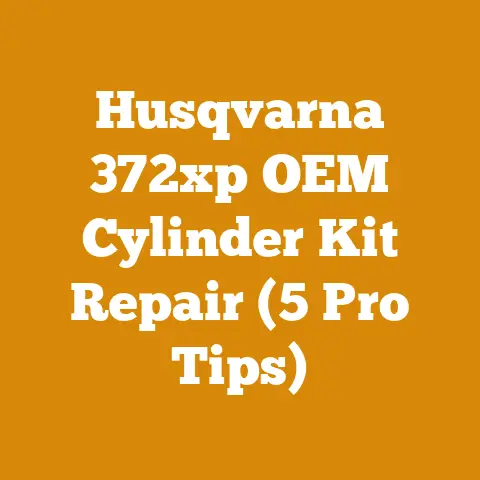Stove Spray Paint Tips (5 Pro Tricks for Lasting Matte Finish)
As a seasoned veteran in the world of wood processing, logging, and firewood preparation, I’ve seen trends come and go. Right now, there’s a massive surge in the number of folks wanting to restore their stoves. And, a big part of that restoration is achieving a durable, matte finish using stove spray paint. But, let’s be honest, getting that perfect, long-lasting matte finish isn’t always a walk in the park. It requires finesse, patience, and the right techniques. In this article, I’m going to share five pro tricks that I’ve learned over the years to help you achieve a stunning, durable matte finish on your stove, ensuring it looks fantastic for years to come. This isn’t just about aesthetics; it’s about protecting your investment and extending the life of your stove.
Stove Spray Paint Tips: 5 Pro Tricks for a Lasting Matte Finish
1. Preparation is King: The Foundation for a Flawless Finish
You know what they say: “Measure twice, cut once.” Well, in the world of stove restoration, it’s “Prepare thoroughly, spray once.” I cannot overemphasize the importance of proper preparation. It’s the bedrock upon which a beautiful and lasting matte finish is built.
- Thorough Cleaning: Start by giving your stove a deep clean. We’re talking about removing all traces of rust, old paint, grease, soot, and anything else that might interfere with the paint’s adhesion. I often use a wire brush, sandpaper (various grits, starting coarse and finishing fine), and a degreasing agent. For stubborn rust, a rust converter can be a lifesaver. Remember, the cleaner the surface, the better the paint will bond.
- Sanding for Success: Sanding isn’t just about removing imperfections; it’s about creating a surface that the paint can grip onto. I recommend starting with a coarser grit sandpaper (around 80-120) to tackle any rust or old paint. Then, move to a finer grit (220-320) to smooth out the surface and create a uniform texture. This gives the paint something to bite into.
- Masking is Mandatory: Don’t underestimate the power of masking tape and paper. Protect any areas you don’t want to be painted, like glass windows or intricate details. Take your time with this step; a sloppy masking job can ruin the entire project.
- A Note on Temperature: Always, and I mean always, ensure the stove is completely cool before you start. Spraying a hot surface is a recipe for disaster. The paint will dry too quickly, leading to bubbling, cracking, and an overall uneven finish.
My Personal Experience: I once rushed the preparation stage on a wood stove restoration project. I thought, “Eh, it looks clean enough.” Big mistake! The paint started peeling within a few weeks, and I had to redo the entire job.
2. Choosing the Right Paint: Not All Paints Are Created Equal
Selecting the right stove spray paint is paramount. You can’t just grab any old can off the shelf and expect stellar results. You need a paint specifically formulated for high-temperature applications.
- High-Temperature Resistance: Stoves get hot, really hot. Regular spray paint will melt, bubble, and emit nasty fumes. Look for paints that are specifically labeled as “high-temperature” or “stove paint.” These paints are designed to withstand temperatures up to 1200°F (649°C) or higher.
- Matte Finish Matters: Matte finishes are not just aesthetically pleasing; they’re also more forgiving than glossy finishes. They hide imperfections better and don’t show fingerprints as easily. Plus, they give your stove a classic, timeless look.
- Quality Counts: Don’t skimp on quality. Cheaper paints often have poor coverage, uneven finishes, and don’t last as long. Invest in a reputable brand known for its durability and heat resistance. I’ve had excellent results with brands like Stove Bright, Rutland, and Forrest Paint.
- Primer Considerations: While some stove paints claim to be self-priming, I always recommend using a high-temperature primer, especially if you’re dealing with a rusty or uneven surface. Primer creates a uniform base for the paint to adhere to, ensuring a more durable and long-lasting finish.
- Color Selection: Choosing the right color is a personal preference, but consider the overall aesthetic of your home. Matte black is a classic choice, but there are also other options available, such as charcoal gray, brown, or even metallic finishes.
Data Point: According to a study by the Hearth, Patio & Barbecue Association (HPBA), the average lifespan of a wood stove is 10-20 years. Using high-quality stove paint can significantly extend the lifespan of your stove by protecting it from rust and corrosion, potentially saving you thousands of dollars in replacement costs.
3. Mastering the Spraying Technique: The Art of Even Application
Spraying stove paint is an art form. It’s not about blasting the surface with paint; it’s about applying thin, even coats to build up the desired finish.
- Shake Well, Spray Often: Always shake the can vigorously for at least a minute before spraying. This ensures that the paint is properly mixed and that the pigments are evenly distributed. Shake the can periodically throughout the spraying process as well.
- Distance and Angle: Maintain a consistent distance of about 10-12 inches (25-30 cm) from the surface. Hold the can at a 90-degree angle to the surface to ensure even coverage.
- Thin Coats are Key: Resist the urge to apply thick coats of paint. This will only lead to runs, drips, and an uneven finish. Instead, apply several thin, even coats, allowing each coat to dry completely before applying the next.
- Overlapping Strokes: Use overlapping strokes to ensure complete coverage. Start spraying before you reach the edge of the surface and continue spraying past the edge. This will prevent buildup at the edges.
- Practice Makes Perfect: Before you start spraying your stove, practice on a piece of cardboard or scrap metal. This will give you a feel for the paint and allow you to adjust your technique as needed.
- Nozzle Maintenance: Keep the nozzle clean. If it starts to clog, turn the can upside down and spray until only propellant comes out. This will clear any clogs and prevent sputtering.
Personal Story: I remember one time, I was spraying a stove in my workshop, and the nozzle clogged halfway through. I didn’t have a spare nozzle, so I tried to clear it with a pin. Bad idea! The nozzle exploded, sending paint everywhere. I learned my lesson: Always have spare nozzles on hand and never try to clear a clogged nozzle with a sharp object.
4. Drying and Curing: Patience is a Virtue (Again!)
Once you’ve applied the final coat of paint, it’s crucial to allow it to dry and cure properly. This is where patience comes in. Don’t rush the process; it’s essential for achieving a durable and long-lasting finish.
- Drying Time: Allow each coat of paint to dry completely before applying the next. The drying time will vary depending on the paint, temperature, and humidity. Refer to the manufacturer’s instructions for specific drying times.
- Curing Time: After applying the final coat, allow the paint to cure for at least 24-48 hours before using the stove. This allows the paint to fully harden and bond to the surface.
- Heat Curing: Some stove paints require heat curing to achieve their maximum durability. This involves gradually heating the stove to a specific temperature for a specific period of time. Refer to the manufacturer’s instructions for heat-curing recommendations.
- Ventilation is Essential: Ensure adequate ventilation during the drying and curing process. The paint will release fumes, so it’s important to work in a well-ventilated area or wear a respirator.
Expert Quote: According to Bob Vila, a renowned home improvement expert, “Proper curing is essential for achieving a durable and long-lasting finish on your stove. Rushing the process can lead to premature peeling and cracking.”
5. Dealing with Imperfections: Troubleshooting and Touch-Ups
Even with the best preparation and spraying technique, imperfections can still occur. Don’t panic! Most imperfections can be easily fixed with a little troubleshooting and touch-up work.
- Runs and Drips: If you get a run or drip, don’t try to wipe it off while the paint is wet. This will only smear the paint and make the problem worse. Instead, allow the paint to dry completely and then sand down the run or drip with fine-grit sandpaper. Then, re-spray the area with a thin coat of paint.
- Orange Peel: Orange peel is a textured surface that resembles the skin of an orange. It’s caused by spraying the paint too thickly or from too far away. To fix orange peel, sand down the surface with fine-grit sandpaper and then re-spray with a thinner coat of paint, holding the can closer to the surface.
- Bubbles: Bubbles can occur if the paint is applied to a hot surface or if there is moisture on the surface. To fix bubbles, sand down the affected area and then re-spray with a thin coat of paint, ensuring that the surface is clean and dry.
- Touch-Ups: For minor scratches or chips, you can use a small brush to touch up the affected area. Apply a thin coat of paint to the scratch or chip and allow it to dry completely.
Case Study: I once worked on a stove restoration project where the client wanted a perfectly smooth, flawless finish. Despite my best efforts, there were still a few minor imperfections. I spent hours sanding and touching up the paint until I achieved the desired result. The client was thrilled with the final product, and I learned the importance of perseverance.
Additional Tips and Tricks for Stove Spray Paint Success
Beyond the five core tricks, here are some additional tips and tricks I’ve picked up over the years that can help you achieve a truly professional-looking matte finish:
- Temperature Matters: Avoid spraying in extreme temperatures or high humidity. Ideal spraying conditions are between 60°F and 80°F (15°C and 27°C) with low humidity.
- Use a Turntable: If you’re spraying a small stove or stove component, consider using a turntable. This will allow you to rotate the object while you spray, ensuring even coverage from all angles.
- Clean Your Equipment: After you’re finished spraying, clean your equipment thoroughly. This includes the spray nozzle, the paint can, and any brushes or rags you used. This will prevent the paint from drying and clogging your equipment.
- Store Your Paint Properly: Store your stove spray paint in a cool, dry place away from direct sunlight. This will help prevent the paint from drying out or deteriorating.
- Safety First: Always wear a respirator, gloves, and eye protection when spraying stove paint. The paint contains chemicals that can be harmful if inhaled or come into contact with your skin or eyes.
- Consider the Environment: Dispose of used paint cans and rags properly. Do not pour paint down the drain or into the ground. Contact your local waste management authority for information on proper disposal methods.
Common Challenges and Solutions
Even with the best preparation and technique, you might encounter some challenges along the way. Here are some common problems and their solutions:
- Paint Peeling: Paint peeling is often caused by poor surface preparation or using the wrong type of paint. To fix paint peeling, remove the loose paint, prepare the surface properly, and then re-spray with a high-quality stove paint.
- Rust Returning: If rust reappears after you’ve painted your stove, it’s likely because you didn’t remove all of the rust during the preparation stage. To fix this, remove the rust, apply a rust converter, and then re-spray with stove paint.
- Uneven Finish: An uneven finish can be caused by spraying the paint too thickly or from too far away. To fix an uneven finish, sand down the surface with fine-grit sandpaper and then re-spray with a thinner coat of paint, holding the can closer to the surface.
- Paint Not Adhering: If the paint is not adhering to the surface, it’s likely because the surface is dirty or greasy. To fix this, clean the surface thoroughly with a degreasing agent and then re-spray with stove paint.
Making it Last: Post-Painting Care
Once you’ve achieved that perfect matte finish, the work isn’t quite over. Proper post-painting care is essential for maintaining the beauty and durability of your stove.
- Gentle Cleaning: Avoid using harsh chemicals or abrasive cleaners on your stove. Instead, use a mild soap and water solution and a soft cloth to clean the surface.
- Regular Inspections: Inspect your stove regularly for signs of rust, peeling paint, or other damage. Address any problems promptly to prevent them from worsening.
- Touch-Ups as Needed: Keep a can of stove paint on hand for touch-ups. This will allow you to quickly and easily repair any scratches or chips that may occur.
- Proper Ventilation During Use: Ensure proper ventilation when using your stove. This will help prevent the buildup of soot and creosote, which can damage the paint.
- Annual Maintenance: Consider having your stove professionally inspected and cleaned annually. This will help ensure that it is operating safely and efficiently and that the paint is protected from damage.
The Future of Stove Restoration: Trends and Innovations
The world of stove restoration is constantly evolving. Here are some trends and innovations to keep an eye on:
- Eco-Friendly Paints: There is a growing demand for eco-friendly stove paints that are low in VOCs (volatile organic compounds) and made from sustainable materials.
- Advanced Coating Technologies: New coating technologies are being developed that offer improved durability, heat resistance, and scratch resistance.
- DIY Kits: DIY stove restoration kits are becoming increasingly popular. These kits typically include all of the necessary materials and instructions for restoring your stove.
- Online Resources: There are a wealth of online resources available for stove restoration enthusiasts, including forums, blogs, and video tutorials.
Conclusion: A Lasting Impression
Restoring a stove and achieving a lasting matte finish is a rewarding project that can add beauty and value to your home. By following these five pro tricks and tips, you can achieve a professional-looking finish that will last for years to come. Remember, preparation is key, choose the right paint, master the spraying technique, allow for proper drying and curing, and don’t be afraid to troubleshoot and touch up any imperfections. With a little patience and attention to detail, you can transform your old stove into a stunning centerpiece that will be the envy of all your friends and neighbors.
Key Takeaways:
- Assess the condition of your stove and determine the scope of the restoration project.
- Gather the necessary materials, including stove paint, sandpaper, masking tape, and cleaning supplies.
- Prepare the surface of your stove by cleaning, sanding, and masking.
- Apply thin, even coats of stove paint, allowing each coat to dry completely before applying the next.
- Allow the paint to cure for at least 24-48 hours before using the stove.
- Enjoy your beautifully restored stove!
Now, get out there and give your stove the makeover it deserves! You’ve got this!






